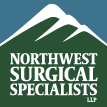Northwest Surgical Specialists has changed
Our surgeons are now at their new homes – with new phone numbers. More information is below.
PeaceHealth Surgical Specialties
Dr. Bascom, Dr. Clark, Dr. Cusati, Dr DeHaas, Dr. Ingalls, Dr. Modeste and Dr. Muilenberg are now part of PeaceHealth Surgical Specialties at Northwest Specialty Clinics. The new main office number is (541) 222-8333. They will continue to see patients in the previous Northwest Surgical Specialist office at 3355 RiverBend Drive, Suite 300 in Springfield, OR. Our practice has been renamed “PeaceHealth Surgical Specialties at Northwest Specialty Clinics.” The phone numbers will not change for physicians remaining at this location. The new clinic webpage is PeaceHealth Surgical Specialties at Northwest Specialty Clinics
Dr. Seidman has a new practice
Dr. Seidman is pleased to announce the opening of his new practice. Northwest Vascular Specialists, located at 1 Hayden Bridge Way in Springfield. Please do not hesitate to reach out with questions or for an appointment by phone at 541-868-9880 or by fax at 541-868-9920. He looks forward to helping you with your vascular needs.
You can visit Dr. Seidman’s website at nwvascularspecialists.com .
Other surgeons
Dr. Schumacher has relocated to Salem Health Surgery Clinic in Salem, OR in June, 2023. His new office number is (503) 814-8272.
Dr. Amit Kainth has relocated to Virginia Mason Medical Center in Tacoma, WA. His new office number is (253) 366–5859.
Medical Records
If you would like a copy of your Northwest Surgical Specialists medical records you may submit a request to the Records Custodian at Morgan Records Management: MorganRecordsManagement.com > Patient Records Requests> Request My Medical Records
Email: Medical@MorganRM.com
Phone 833-888-0061


